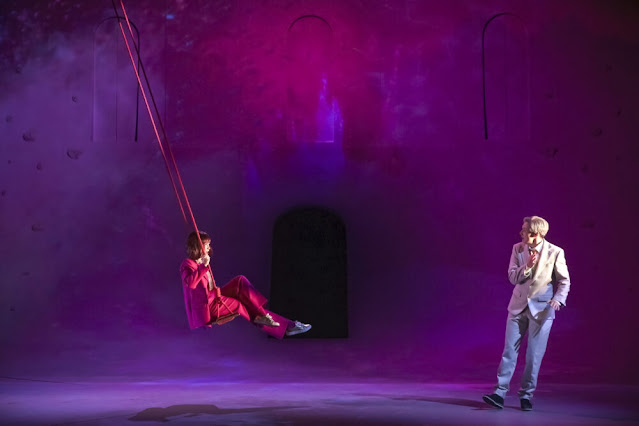
This intelligent and extremely entertaining double bill of Gluck and Purcell at Grange Festival has three stars: the cast, the orchestra, and Robert Innes Hopkins. Why Hopkins? Because the set is pivotal to not only both dramas but enables this special opera festival to present two works with minimal production changes.

Alexandra Oomens and Heather Lowe
He gives Grange Festival a back wall with three doors, curving down to the stage floor which doubles as a climbing wall for the rather brave players, and an entire stage-space video screen. For Gluck it enables the transformations from an Arcadian idyll to a stylised hell (a ruined city where the inhabitants of Hades writhe around like insects in a trap and cannot get out. In the Purcell the contrast could not be more different. Here the video projections are of glossy glamour magazines, telling the story of celebrities Dido and then Aenaes as international superstars, tracing their back story, their meeting, romance and then separation. There is much use of mobile phones and tweeting with hashtagged messages being displayed on that video wall. It all makes perfect sense. Bravo video designer Nina Dunn.

Caroline Blair and Heather Lowe
This is a strong collaboration between director Daniel Slater, Harry Christophers and The Sixteen returned for Gluck’s 1762 version of Orfeo ed Euridice and Purcell’s Dido and Aeneas.
For the Gluck we have the elegant choreography from Tim Claydon, the chorus in pastoral dresses and smart summer suits for the wedding celebrations, their individual voices clearly discernible, then the scene changes to the underworld where a fun Amore from a sprightly Caroline Blair, literally swings in to advise the vivaciously acted and sung Orfeo from Heather Lowe not to give up on his quest to bring back Euridice, a sparkling Alexandra Oomens.

Heather Lowe and the Furies
What is particularly enjoyable about this Orfeo and Euridice is the youthfulness of the cast. Lowe is very persuasive and an energetic young groom with her gentleness of mezzo and agility of movement and then seriousness as he tries to follow his instructions. This contrasts with the more dare I say neurotic Euridice who cannot cope with his reluctance to engage.
That clever wall comes into its own again as our agile hero climbs up its slope to bring Euridice, who also makes it most of the way, before her appeals for a bit of attention succeeds and her fate is (sort of sealed).
Also, very effective (and repeated in a different form in the Purcell) red ropes wind around that back wall and then are used to trap and guide the young lovers. In the Purcell this idea is repeated using images of the computer chip electronic networks that similarly control or at least influence the drama.
The ending of the Gluck is more nuanced than the happy ever ending, where Amore gets involved again for another reuniting of the lovers. We appear to be back at the wedding scene with Orfeo rather baffled how he is in Ground Hog Day. The opera ends with Euridice standing at the tomb / entrance to Hades and Orfeo continuing an endless solo movement choreography as the light focuses on him and then dies. Wonderful stuff.
The music is sublime from Christophers and in this delightful auditorium all the delicacies and individuality of the players can be enjoyed. Similarly, the singers are exquisite with Orfeo tremendous. That chorus comprises members of the The Sixteen with the Grange Festival Chorus. It is also rather amazing how these clearly fit young people clamber up and throw themselves down the sloping back wall. Lowe’s dance training is evident, and the other players enter the dance choreography with style and polish.
These lovely two singers come back together for the Purcell, this time as Belinda and the doomed Queen of Carthage. Belinda is the seemingly sensible PA to the glamour puss Dido. Filled with ennui she slouches around her ritzy apartment while the magazine front pages on the video wall tell us of the huge successes of her empire and also the running story of Aenaes and the fall of Troy. Belinda and the dowdier second woman sung by Caroline Blair, keeps checking her tablet and the pair have obviously been plotting as when the handsome (and he is) Aenaes in the form of James Newby arrives, the suitcases are packed for their jaunt. Rather than the hunt and storm, our lovers fly off to a sun-soaked paradise resort (the pilot and cabin crew scene is perfection).

Heather Lowe and James Newby
In Slater’s direction, we also have our version of the dark arts in the form of the Sorceress we have a deliciously evil Helen Charlston in dominatrix leather and boots. When those versatile dancers are back they do all of the sort of gyrating around you would expect but also superbly form a human sofa for their mistress to sit on. There is a lot of playing up for whimsy such as the rather jolly witches from Kirsty Hopkins and Katy Hill. George Pooley is appealingly sung in the role of Sailor, here another flying chappie.

Helen Charlston
Lowe is at her best when given full rein (vocally and dramatically) and while the romantic duets with Newby are dreamy the final collapse of the distraught queen is not terribly convincing, although more pathos than emotionally convincing.
As a classical historian it is also a little surreal listening to audience members struggling with their explanations to each other about the story of Aeneas and Dido and resisting temptation to advise them to enrich their lives by getting themselves a copy of Virgil’s Aeneid.
.